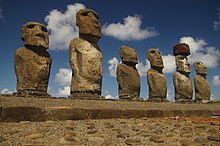Hotu-iti

Hotu-iti (also, "Tongariki territory") is an area of southeastern Easter Island that takes its name from a local clan. Located in Rapa Nui National Park, the area includes Rano Raraku crater, the Ahu Tongariki site, and a small bay. In the 15th and 16th centuries, the Hotu-iti clan was one of two polities on Easter Island.
Geography[edit]
Hotu-iti contains Rano Raraku crater, which is the island's only source of a type of stone that was considered to be the best for carving statues; it was also a source of moss which was used for canoe caulking.[1] Hotuiti Bay, a small cove, is protected by the cliffs of the Poike Peninsula.[2][3] According to local legend, the god Tangaroa was killed in the bay and was buried in the vicinity.[4] The Rano Raraku cliffs and quarry stand above Hotu-iti. The landscape has been described as a "wondrous spiritual landscape of striking beauty".[5][6]
History[edit]

In the 15th and 16th centuries, the island was divided into two polities, described as either west (Tu'u)[7] and east (Hotu-iti) confederacies, with Hotu-iti being the lower ranked;[5] or northern (Tu'u Aro) and southern (Hotu-iti).[8] In 1960, a tsunami, approximately 6 metres (20 ft) above sea level, crossed 500 metres (1,600 ft) of Hotu-iti, sweeping away ahu and moai (statues), and scattering them by 50–150 metres (160–490 ft).[9] Fifteen statues of Hotu-iti's Ahu Tongariki site were damaged;[10] a team of Japanese archaeologists restored the site between 1992 and 1994.[10]
Leadership[edit]
In Polynesian mythology, Hotu-iti was the youngest and favourite son of Hotu Matu'a, the legendary first settler of Easter Island.[10][11] One of the known chiefs of the Hotu-iti clan was Kainga, said to be a descendant of the sixth son of the first king who "proved himself a valiant warrior." He had a son who succeeded him named Huriavai.[12] The Tupahotu, Koro-Orongo and Ure-o-Hei clans were considered part of the Hotu-iti clan.[13]
References[edit]
- ^ Diamond, Jared (4 January 2011). Collapse: How Societies Choose to Fail Or Succeed. Penguin. pp. 94–. ISBN 978-0-14-311700-1. Retrieved 21 July 2012.
- ^ Theroux, Paul (8 December 2006). The Happy Isles of Oceania: Paddling the Pacific. Houghton Mifflin Harcourt. pp. 456–. ISBN 978-0-618-65898-5. Retrieved 21 July 2012.
- ^ Russell, Jan Jarboe (1 November 2007). They Lived to Tell the Tale: True Stories of Modern Adventure from the Legendary Explorers Club. Globe Pequot. pp. 295–. ISBN 978-1-59228-991-2. Retrieved 21 July 2012.
- ^ Englert, Sebastián (1970). Island at the center of the world: new light on Easter Island. Scribner. p. 169. Retrieved 20 July 2012.
- ^ a b Peregrine, Peter Neal; Ember, Melvin (2001). Encyclopedia of Prehistory: East Asia and Oceania. Springer. p. 57. ISBN 978-0-306-46257-3. Retrieved 20 July 2012.
- ^ Tilburg, JoAnne Van (1 April 2003). Among stone giants: the life of Katherine Routledge and her remarkable expedition to Easter Island. Scribner. ISBN 978-0-7432-4480-0. Retrieved 20 July 2012.
- ^ The Enigmas of Easter Island. Oxford University Press. pp. 212–. ISBN 978-0-19-164719-2. Retrieved 21 July 2012.
- ^ Gillespie, Rosemary G.; Clague, D. A. (19 August 2009). Encyclopedia of Islands. University of California Press. pp. 249–. ISBN 978-0-520-25649-1. Retrieved 21 July 2012.
- ^ Dudley, Walter C.; Lee, Min (1998). Tsunami!. University of Hawaii Press. pp. 142–. ISBN 978-0-8248-1969-9. Retrieved 21 July 2012.
- ^ a b c Stanley, David (1 January 2000). South Pacific Handbook. David Stanley. p. 296. ISBN 978-1-56691-172-6. Retrieved 20 July 2012.
- ^ Craig, Robert D. (1 October 1989). Dictionary of Polynesian Mythology. Greenwood Publishing Group. p. 76. ISBN 978-0-313-25890-9. Retrieved 20 July 2012.
- ^ Thomson, William J. (2007). Te Pito Te Henua, Or Easter Island. Forgotten Books. p. 138. ISBN 978-1-60506-953-1. Retrieved 20 July 2012.
- ^ Akadémia, Magyar Tudományos (1961). Acta ethnographica. Magyar Tudományos Akadémia. p. 399. Retrieved 20 July 2012.
